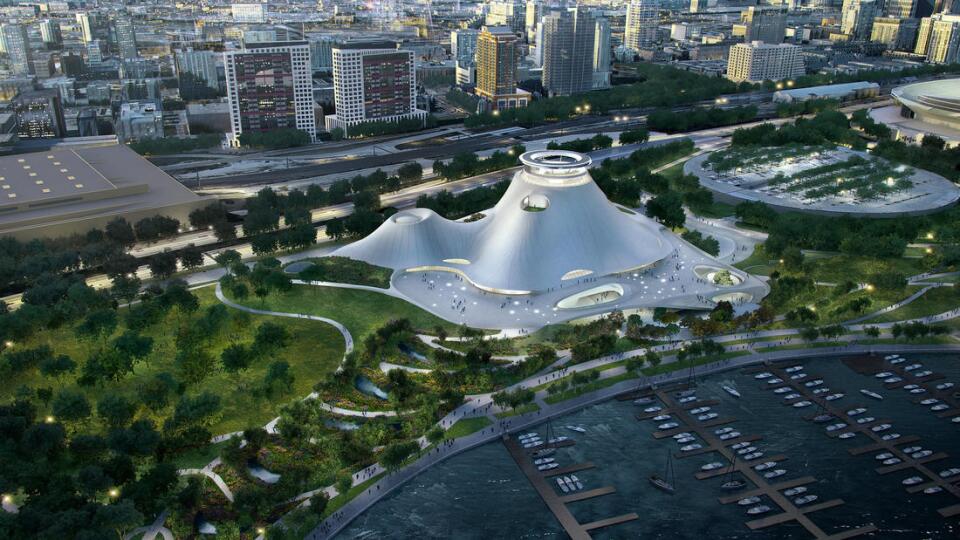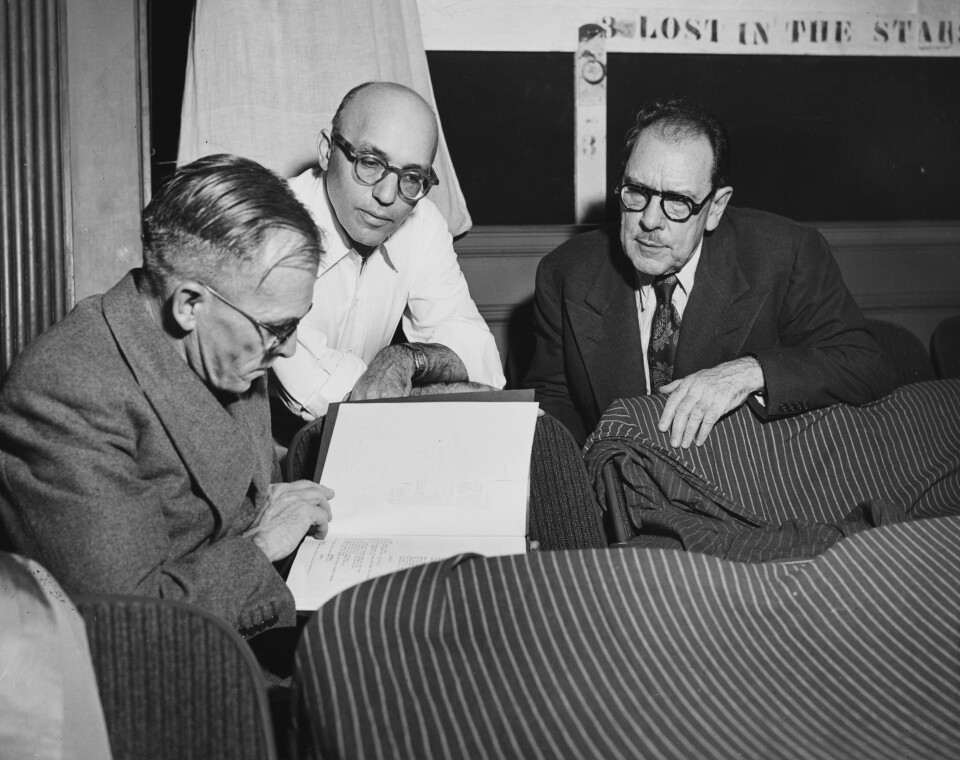News that filmmaker George Lucas will build a museum for his personal art collection in Los Angeles has a lot of people talking about "Star Wars" but this passion project will house more than memorabilia, says L.A. Times architecture critic Christopher Hawthorne; and Jeffrey Kahane, the musician and conductor who led the LA Chamber Orchestra for two decades now leads the Lift Every Voice music festival which challenges racial and religious injustice.
The Lucas Museum's long 'tortured' road to Los Angeles
After more than three years of bureaucratic roadblocks, false starts and some old-fashioned city rivalry, the Lucas Museum of Narrative Art has finally found a home in Los Angeles.
The long-awaited museum will house the art and movie memorabilia collection of director George Lucas. It includes "Star Wars" related pieces, but also the work of artists such as Norman Rockwell and Edgar Degas.

Lucas first set his sights on San Francisco's Presidio park as the location for the museum, but a failed negotiation over the land led to a new proposal for Chicago. This second iteration of the museum was eventually dropped after much debate and controversy over the use of lakefront property.

After a final battle between Los Angeles and San Francisco — where a new design was later proposed in a different location, Treasure Island — the Lucas Museum announced this week that it will finally land in L.A.'s Exposition Park. Construction is set to begin before the end of the year, but won't be completed until 2021.

Los Angeles Times architecture critic Christopher Hawthorne has covered the Lucas Museum's long search for a home since L.A. first became a contender last year. He joined the Frame's John Horn to discuss the project's history and what this means for the city.
Interview Highlights
On the art collection itself:
[George Lucas has] been collecting art for many years: movie memorabilia — costume design, storyboards, things connected to his own films, the "Star Wars" series, but also "The Ten Commandments," famous films in Hollywood history. At the same time, he's been collecting fine art — some Impressionist work, but it's particularly strong in figurative American art. Norman Rockwell is really the core of that side of the collection. And he's brought these two halves of his collection together and has proposed building this museum, which is now called the Lucas Museum of Narrative Art. He uses that term, "narrative art," to bring together these two halves and explains it as a collection that's about art that tells a story. I think it's a somewhat awkward attempt to marry the two halves of this collection.
On the evolution of the museum's design:
[Lucas] moved from this very traditional, classically-minded proposal for San Francisco to a very futuristic, streamlined, kind of aerodynamic architecture for Chicago. After he ran into problems in Chicago, he moved back to California [and] he stuck with Ma Yansong, this Chinese architect [he'd hired for the Chicago plan], but he split the proposal. He had one proposal from Ma Yansong back in San Francisco, and another in Exposition Park in Los Angeles, just south of USC and the Coliseum.
On the possibility of attracting a "Star Wars"-loving crowd:
There is some talk that they're going to open it on May 4 [of 2021], which has now become the kind of unofficial "Star Wars" holiday. If that's true, that suggests they're aiming very squarely at that demographic, and I think that's the reason it's been so attractive to politicians like Eric Garcetti and the mayors of San Francisco and Chicago. Just because of the "Star Wars" collection alone, this is a museum that seems destined to draw huge tourist crowds from day one.
On designing a museum for both light sabers and Degas:
The design as it stands now seems to complement the "Star Wars" half of the collection much more than, let's say, the Normal Rockwell half. We haven't really seen layouts of the galleries yet and that will be one of the tests architecturally: How do you produce a museum that works for the light saber half of the collection and also has galleries for a much more traditionally-minded collection? With Degas, with Norman Rockwell, with N.C. Wyeth, and so forth. That's going to be a tough juggling act for the architect and the director of this museum.
Jeffrey Kahane created a music festival to speak out against oppression
After 20 years, Jeffrey Kahane is retiring as music director of the Los Angeles Chamber Orchestra.
A conductor and a pianist, Kahane led the orchestra in interpreting historical masterworks, as well as commissioning new pieces by a wide range of contemporary composers. He’s also the mastermind behind the Lift Every Voice festival — an event promoting community engagement and classical music with a message of peace.
At the heart of this year’s program is a musical by Kurt Weill — the German-Jewish composer who fled Nazi Germany in the '20s and took up asylum in the U.S. A piece he wrote, “Lost In The Stars,” brings together gospel, jazz and opera under one egalitarian vision.
"Lost in the Stars" was inspired by the 1948 novel, “Cry, the Beloved Country,” about South Africa and apartheid, and was Weill’s statement against racial prejudice suffered all over the world.
Kahane’s own mother and grandparents survived the Holocaust and escaped to the U.S. When he stopped by The Frame studios this week, he started by telling host John Horn how his own family history motivated him to create this festival.
Interview Highlights:
On how his family's escape from Nazi Germany inspired him to speak out against prejudice:
My mother and my grandmother didn't talk a lot about Germany, and even though I felt strongly and identified with my German Jewish heritage, I didn't ask a lot of questions. If I did ask questions, my mother would often say, I don't remember — which may or may not have been true. She experienced a lot growing up. She experienced her teenage years in Nazi Germany. After my grandmother died, one of my uncles found among her papers a lengthy document written in German that none of us had known existed, called "Notes from Buchenwald concentration camp." And when I read that document, suddenly this was no longer ancient history, it was no longer an abstraction, it was deeply personal. This was my mother's father and I was reading his words about his experience.
This particular project, "Lift Every Voice," it's very important to stress that this is not a project about the Holocaust. The theme of the festival has to do with speaking out against oppression, against injustice of all forms, in all places and at all times.
On why Kurt Weill's "Lost In The Stars" resonated with him:
Weill, who came here as a refugee, who had to flee Germany because he was a Jew — he was not only a Jew, but he was also a radical artistically. So as with the case with every Jewish composer, his music was banned. He realized, fortunately, early enough that he had to get out. He went to Paris first and then came to the States. In 1949, he and his colleague, Maxwell Anderson, who wrote the book and lyrics for "Lost In The Stars," decided they wanted to do something theatrically and musically that would address the awful situation of black Americans. They chose to do it and found this ideal vehicle in Alan Paton's novel. It was both more practical, more realistic and perhaps more effective in a way to write a piece about apartheid and, in so doing, asking Americans to look our own segregation straight in the eye.

On whether the piece is relevant to a modern audience:
I think it is certainly fair to say that as a country we obviously have made tremendous strides. The fact that we just had a two-term African American president is certainly a testament to that, but it is also true that racism is very much alive in this country. I woke up on the morning after the election to see an image of a swastika painted on a wall in South Philly and, needless to say, it made my blood run cold. It also made me feel that this project that we're doing is indeed far more timely even than I could have imagined two-and-a-half years ago when I started working to develop it.
One of Weill's most extraordinary gifts, something which almost no other 20th Century composer had to this degree, was his ability to speak so many different musical languages. The show — some of it sounds like gospel, some of it sounds like jazz, some of it sounds like opera. And he does it all brilliantly. It's so moving and so powerful. The diversity of the music itself is a reflection of his commitment to the idea of equality.
The "Lift Every Voice" festival runs from Jan. 14-29.




